Separation of Magnesium and Lithium Ions Utilizing Layer-by-Layer Polyelectrolyte Modification of Polyacrylonitrile Hollow Fiber Porous Membranes
Abstract
1. Introduction
2. Materials and Methods
2.1. Materials
2.2. PAN Hollow Fiber Hydrolysis Treatment and Modification
2.3. Characterization and Performance Evaluation Methods
3. Results
3.1. Characterization of LBL Modified Hollow Fiber Membranes
3.2. Separation Performance for Mg2+ and Li+
4. Discussion
5. Conclusions
Supplementary Materials
Author Contributions
Funding
Institutional Review Board Statement
Informed Consent Statement
Data Availability Statement
Acknowledgments
Conflicts of Interest
References
- Zhang, Y.; Fan, Y.; Zhou, G.; Cao, Y.; Wang, J.; Jiang, X.; Zhang, N.; Yin, S. Based on High Cross-Linked Structure Design to Fabricate PEI-Based Nanofiltration Membranes for Mg2+/Li+ Separation. J. Membr. Sci. 2024, 693, 122351. [Google Scholar] [CrossRef]
- Zhang, T.; Zheng, W.; Wang, Q.; Wu, Z.; Wang, Z. Designed Strategies of Nanofiltration Technology for Mg2+/Li+ Separation from Salt-Lake Brine: A Comprehensive Review. Desalination 2023, 546, 116205. [Google Scholar] [CrossRef]
- Wang, H.; Zeng, G.; Yang, Z.; Chen, X.; Wang, L.; Xiang, Y.; Zeng, X.; Feng, Z.; Tang, B.; Yu, X.; et al. Nanofiltration Membrane Based on a Dual-Reinforcement Strategy of Support and Selective Layers for Efficient Mg2+/Li+ Separation. Sep. Purif. Technol. 2024, 330, 125254. [Google Scholar] [CrossRef]
- Zhao, P.; Guo, F.; Wang, L.; Zhen, H.; Zhang, N.; Yin, S.; Zhou, G.; Ruan, X.; He, G.; Jiang, X. Nanofiltration Membrane with Modified Nano-Gradient Structure and Positive Charge for Li Separation from High Mg/Li Ratio Brine. Desalination 2024, 577, 117394. [Google Scholar] [CrossRef]
- Li, Q.; Liu, Y.; Jia, Y.; Ji, Y.; Yan, F.; Li, J.; Mohammad, Y.; He, B. High Performance Li+/Mg2+ Separation Membrane by Grafted Short Chain Amino-Rich Monomers. J. Membr. Sci. 2023, 677, 121634. [Google Scholar] [CrossRef]
- Ni, H.; Wang, N.; Yang, Y.; Shen, M.; An, Q.-F. Positively-Charged Nanofiltration Membrane Constructed by Polyethyleneimine/Layered Double Hydroxide for Mg2+/Li+ Separation. Desalination 2023, 548, 116256. [Google Scholar] [CrossRef]
- Sun, Y.; Wang, Q.; Wang, Y.; Yun, R.; Xiang, X. Recent Advances in Magnesium/Lithium Separation and Lithium Extraction Technologies from Salt Lake Brine. Sep. Purif. Technol. 2021, 256, 117807. [Google Scholar] [CrossRef]
- Jia, R.; Wu, L.-K.; Xu, Z.-L.; Hedar, M.; Luo, L.-H.; Wu, Y.-Z.; Li, H.-X.; Tong, Y.-H.; Xu, S.-J. Efficient Separation of Li+/Mg2+ via Positively Charged TFN Membrane Based on the PEI Interlayer. Chem. Eng. Sci. 2024, 284, 119523. [Google Scholar] [CrossRef]
- Zhao, S.; Cui, W.; Shen, Q.; Yao, Z.; Fang, C.; Zhang, L.; Zhu, L. Porous Organic Polymer Interlayers Modulated Nanofiltration Membranes for Ultra-Permselective Li+ /Mg2+ Separation. J. Membr. Sci. 2024, 690, 122207. [Google Scholar] [CrossRef]
- Wamble, N.P.; Eugene, E.A.; Phillip, W.A.; Dowling, A.W. Optimal Diafiltration Membrane Cascades Enable Green Recycling of Spent Lithium-Ion Batteries. ACS Sustain. Chem. Eng. 2022, 10, 12207–12225. [Google Scholar] [CrossRef]
- He, R.; Xu, S.; Wang, R.; Bai, B.; Lin, S.; He, T. Polyelectrolyte-Based Nanofiltration Membranes with Exceptional Performance in Mg2+/Li+ Separation in a Wide Range of Solution Conditions. J. Membr. Sci. 2022, 663, 121027. [Google Scholar] [CrossRef]
- He, R.; Dong, C.; Xu, S.; Liu, C.; Zhao, S.; He, T. Unprecedented Mg2+/Li+ Separation Using Layer-by-Layer Based Nanofiltration Hollow Fiber Membranes. Desalination 2022, 525, 115492. [Google Scholar] [CrossRef]
- Dong, C.; He, R.; Xu, S.; He, H.; Chen, H.; Zhang, Y.-B.; He, T. Layer-by-Layer (LBL) Hollow Fiber Nanofiltration Membranes for Seawater Treatment: Ion Rejection. Desalination 2022, 534, 115793. [Google Scholar] [CrossRef]
- Wang, E.; Liu, S.; Liu, L.; Han, L.; Su, B. Positively Charged Thin-Film Composite Hollow Fiber Nanofiltration Membrane via Interfacial Polymerization and Branch Polyethyleneimine Modification for Mg2+/Li+ Separation. J. Membr. Sci. Lett. 2023, 3, 100061. [Google Scholar] [CrossRef]
- Zhao, Z.; Li, Q.; Gong, J.; Li, Z.; Zhang, J. A Poly(Allylamine Hydrochloride)/Poly(Styrene sulfonate) Microcapsule-Coated Cotton Fabric for Stimulus-Responsive Textiles. RSC Adv. 2020, 10, 17731–17738. [Google Scholar] [CrossRef]
- Cheng, W.; Liu, C.; Tong, T.; Epsztein, R.; Sun, M.; Verduzco, R.; Ma, J.; Elimelech, M. Selective Removal of Divalent Cations by Polyelectrolyte Multilayer Nanofiltration Membrane: Role of Polyelectrolyte Charge, Ion Size, and Ionic Strength. J. Membr. Sci. 2018, 559, 98–106. [Google Scholar] [CrossRef]
- Sheng, C.; Wijeratne, S.; Cheng, C.; Baker, G.L.; Bruening, M.L. Facilitated Ion Transport Through Polyelectrolyte Multilayer Films Containing Metal-Binding Ligands. J. Membr. Sci. 2014, 459, 169–176. [Google Scholar] [CrossRef]
- Liu, C.; Shi, L.; Wang, R. Crosslinked Layer-by-Layer Polyelectrolyte Nanofiltration Hollow Fiber Membrane for Low-Pressure Water Softening with the Presence of SO42− in Feed Water. J. Membr. Sci. 2015, 486, 169–176. [Google Scholar] [CrossRef]
- Abedi, M.; Sadeghi, M.; Pourafshari Chenar, M. Improving Antifouling Performance of PAN Hollow Fiber Membrane Using Surface Modification Method. J. Taiwan Inst. Chem. Eng. 2015, 55, 42–48. [Google Scholar] [CrossRef]
- Deng, S.; Bai, R.; Chen, J.P. Behaviors and Mechanisms of Copper Adsorption on Hydrolyzed Polyacrylonitrile Fibers. J. Colloid Interface Sci. 2003, 260, 265–272. [Google Scholar] [CrossRef]
- Li, X.; Umar, A.; Chen, Z.; Tian, T.; Wang, S.; Wang, Y. Supramolecular Fabrication of Polyelectrolyte-Modified Reduced Graphene Oxide for NO2 Sensing Applications. Ceram. Int. 2015, 41, 12130–12136. [Google Scholar] [CrossRef]
- Rajabzadeh, S.; Liu, C.; Shi, L.; Wang, R. Preparation of Low-Pressure Water Softening Hollow Fiber Membranes by Polyelectrolyte Deposition with Two Bilayers. Desalination 2014, 344, 64–70. [Google Scholar] [CrossRef]
- Ding, D.; Yaroshchuk, A.; Bruening, M.L. Electrodialysis Through Nafion Membranes Coated with Polyelectrolyte Multilayers Yields >99% Pure Monovalent Ions at High Recoveries. J. Membr. Sci. 2022, 647, 120294. [Google Scholar] [CrossRef]
- Ahmad, M.; Yaroshchuk, A.; Bruening, M.L. Moderate pH Changes Alter the Fluxes, Selectivities and Limiting Currents in Ion Transport Through Polyelectrolyte Multilayers Deposited on Membranes. J. Membr. Sci. 2020, 616, 118570. [Google Scholar] [CrossRef]
- Liu, C.; Shi, L.; Wang, R. Enhanced Hollow Fiber Membrane Performance via Semi-Dynamic Layer-by-Layer Polyelectrolyte Inner Surface Deposition for Nanofiltration and Forward Osmosis Applications. React. Funct. Polym. 2015, 86, 154–160. [Google Scholar] [CrossRef]
- Rajesh, S.; Zhao, Y.; Fong, H.; Menkhaus, T.J. Polyacrylonitrile Nanofiber Membranes Modified with Ionically Crosslinked Polyelectrolyte Multilayers for the Separation of Ionic Impurities. Nanoscale 2016, 8, 18376–18389. [Google Scholar] [CrossRef]

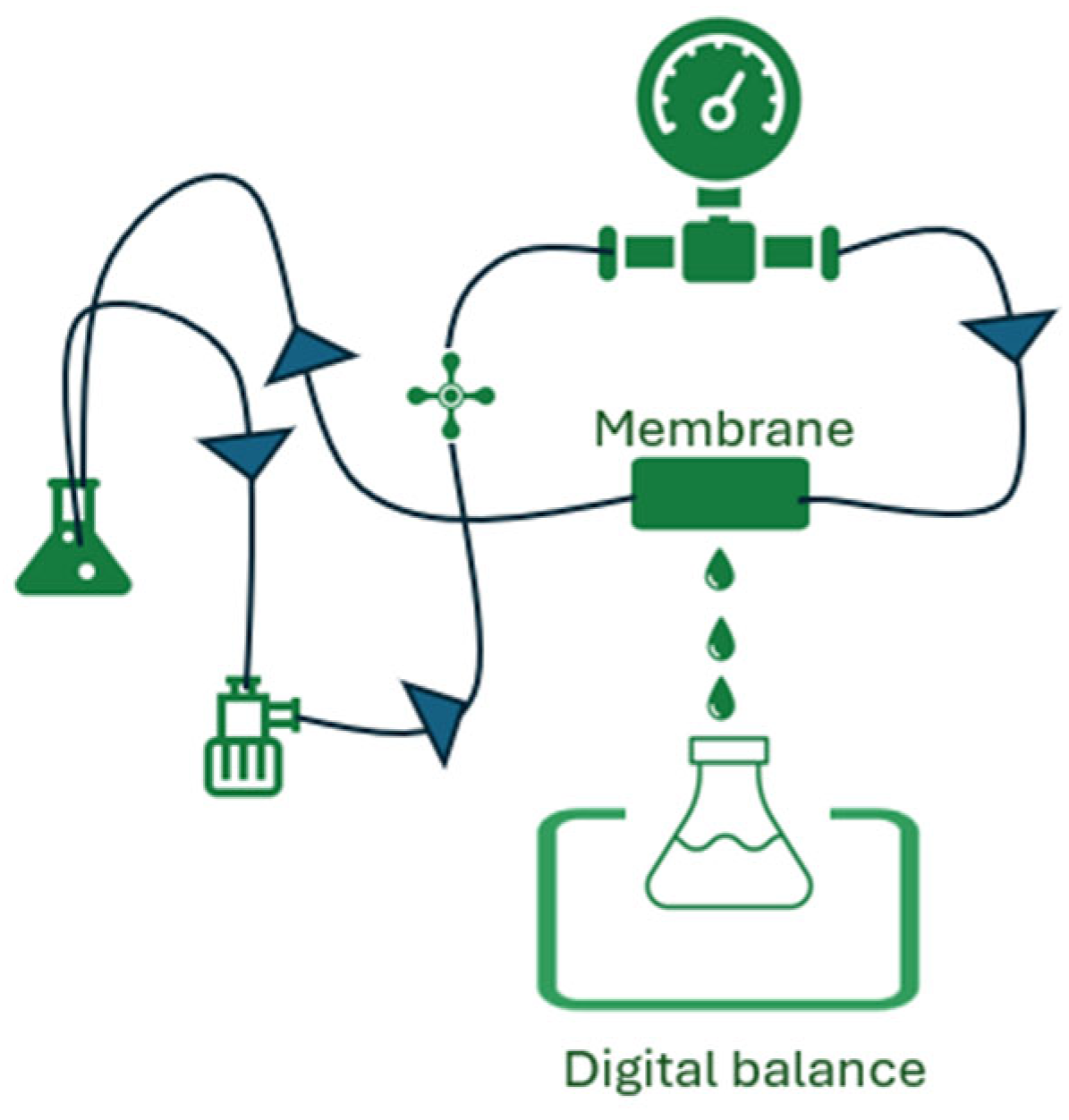
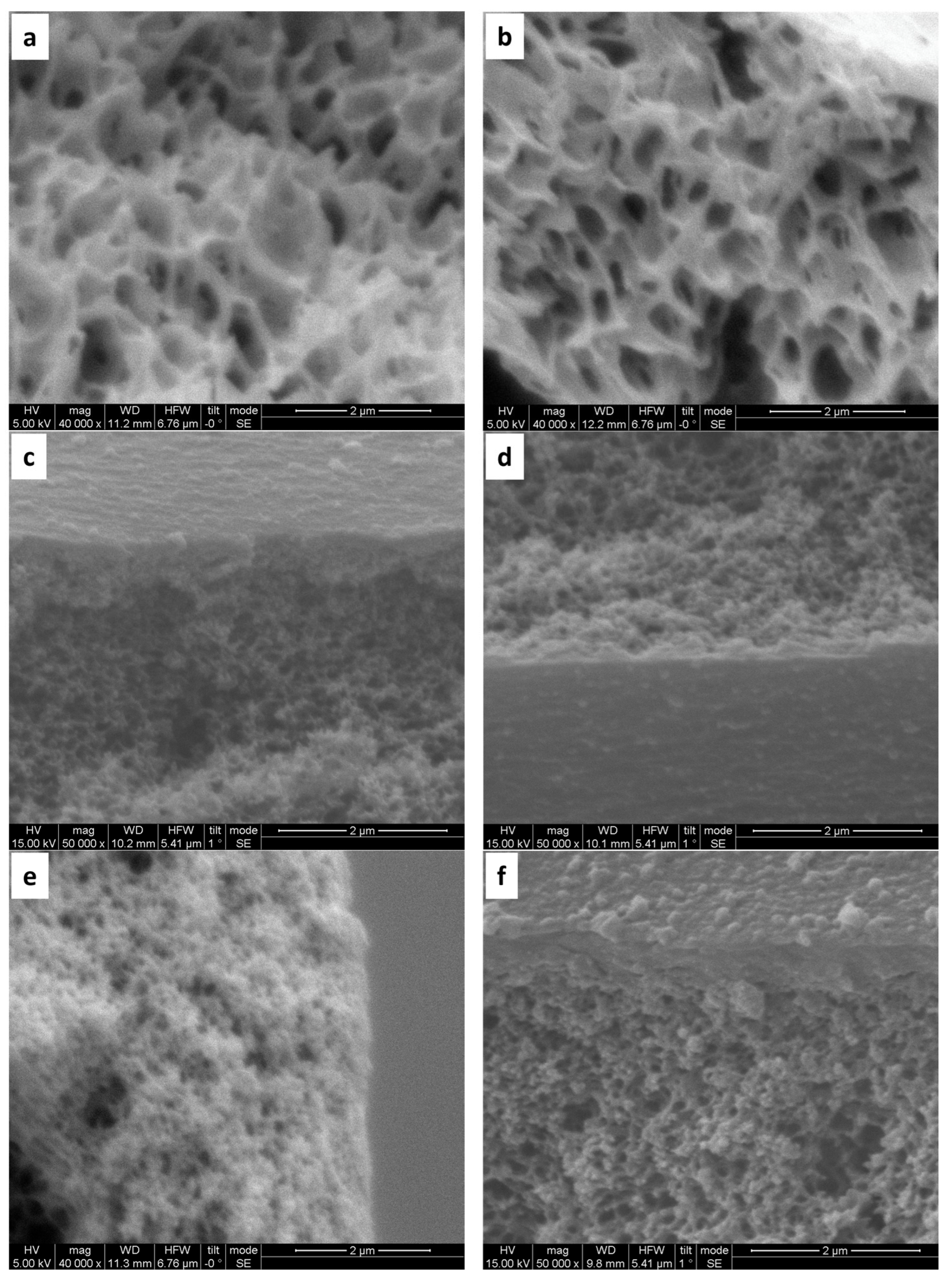

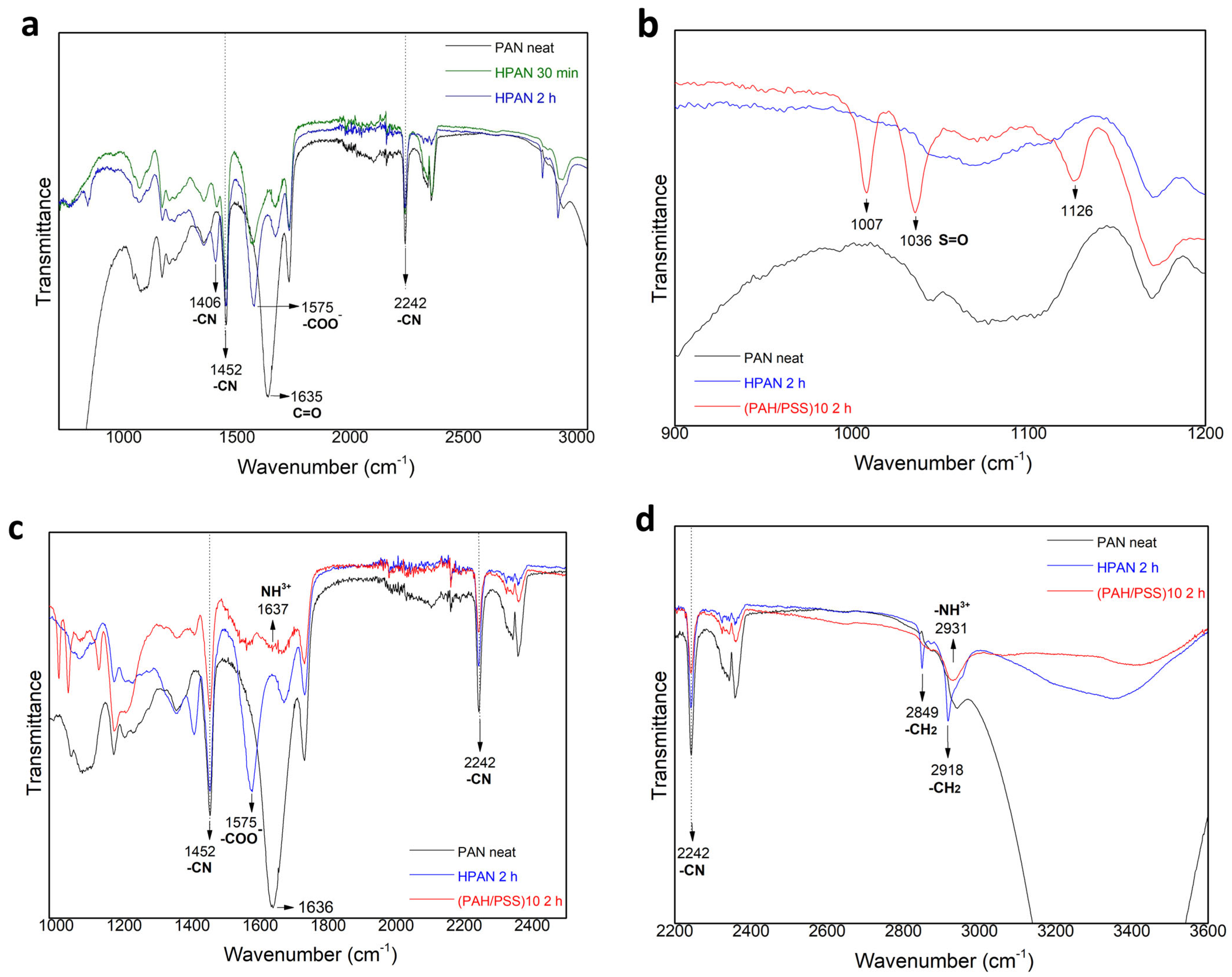
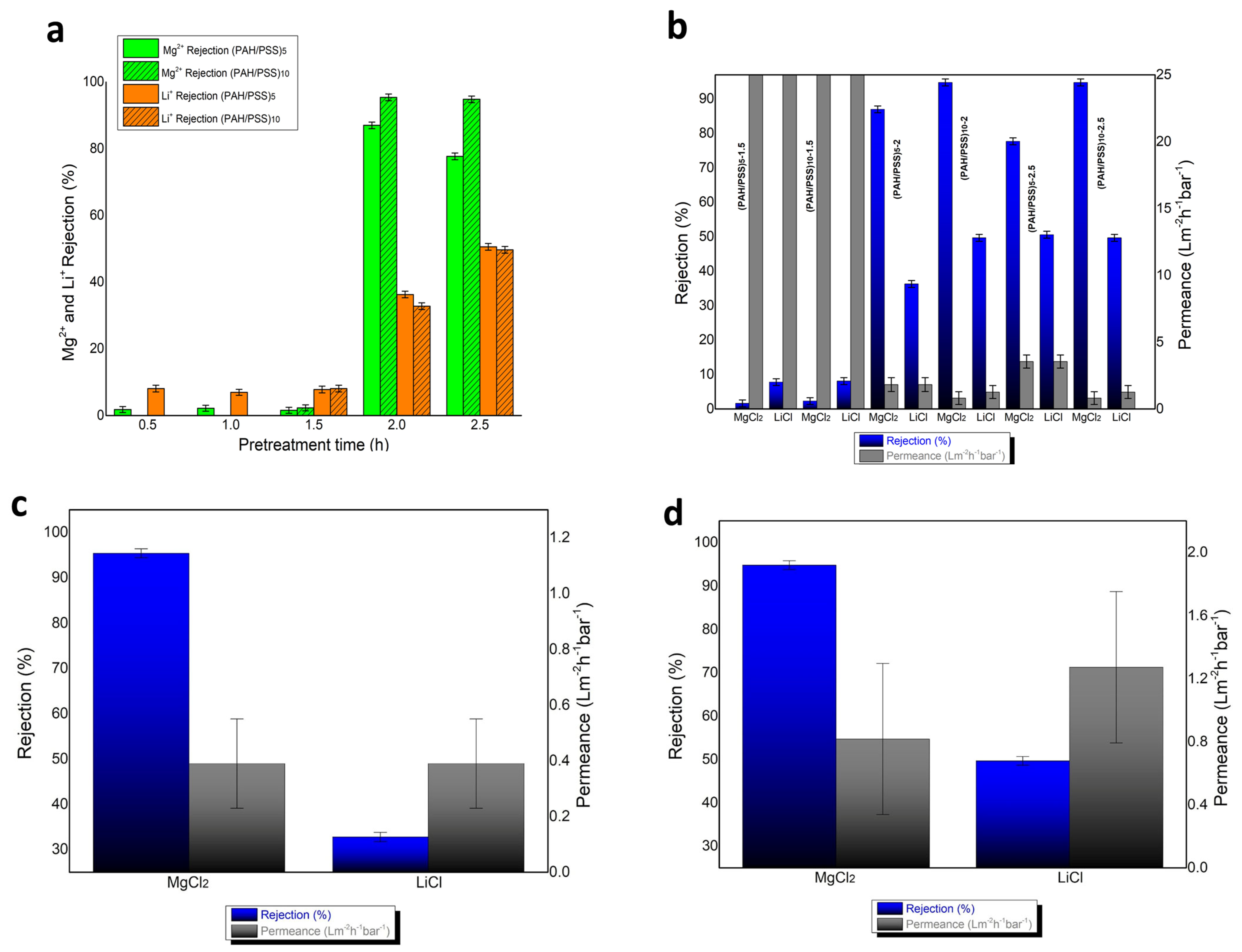
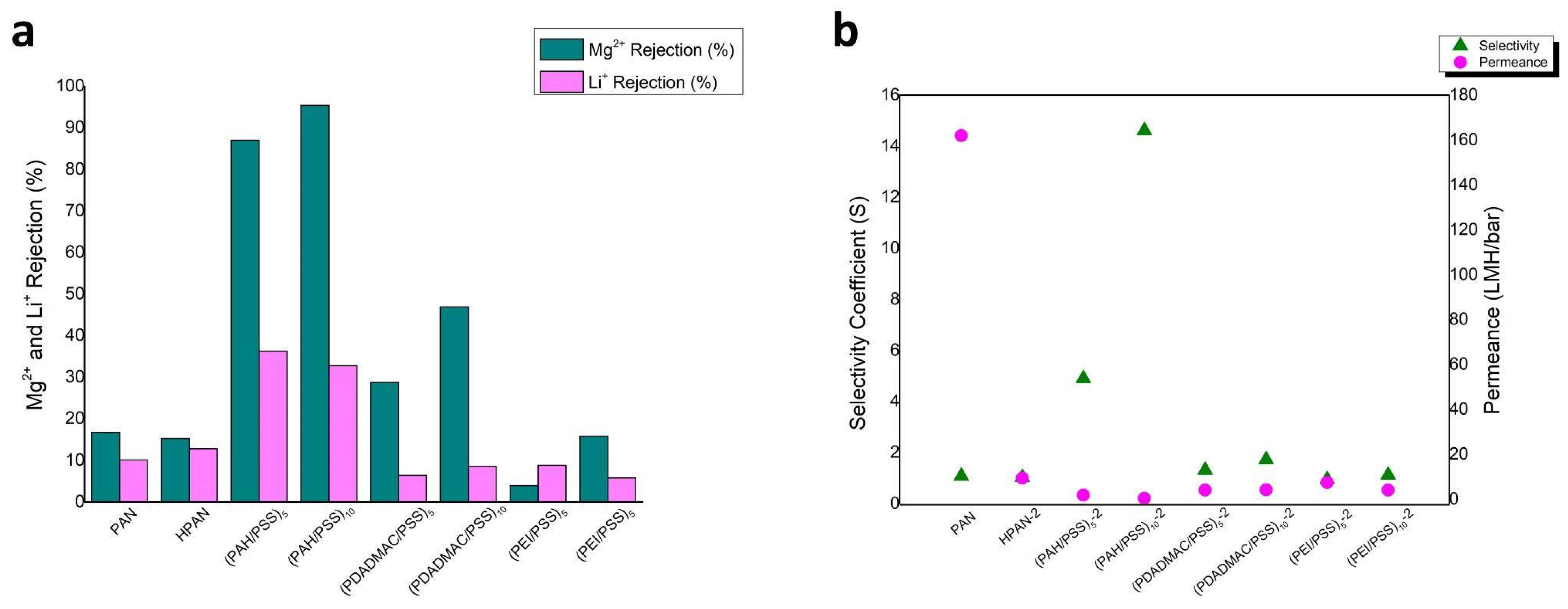
| 1st Week | 2nd Week | 3rd Week | ||||
|---|---|---|---|---|---|---|
| (PAH/PSS)10-2 | (PAH/PSS)10-2.5 | (PAH/PSS)10-2 | (PAH/PSS)10-2.5 | (PAH/PSS)10-2 | (PAH/PSS)10-2.5 | |
| Mg Rejection (%) | 95.40 ± 0.9 | 94.8 ± 1 | 96.00 ± 0.9 | 94.5.2 ± 1 | 95.36 ± 0.9 | 94.8 ± 1 |
| Li Rejection (%) | 32.80 ± 0.9 | 49.7 ± 1 | 32.80 ± 0.9 | 49.6 ± 1 | 31.90 ± 0.9 | 49.8 ± 1 |
| Permeance (LMH/bar) | 0.39 ± 0.47 | 1.04 ± 0.52 | 0.34 ± 0.47 | 1.05 ± 0.52 | 0.35 ± 0.47 | 1.05 ± 0.52 |
| Sample Name | Mg Rejection (%) | Li Rejection (%) | Selectivity Coefficient (S) | Permeance (LMH/bar) |
|---|---|---|---|---|
| PAN | 16.73 ± 1 | 10.11 ± 1 | 1.079 | 161.91 ± 0.51 |
| HPAN-2 | 15.30 ± 1.4 | 12.80 ± 1.4 | 1.030 | 9.37 ± 0.5 |
| (PAH/PSS)5-2 | 87.00 ± 1 | 36.30 ± 1 | 4.900 | 1.83 ± 0.49 |
| (PAH/PSS)10-2 | 95.40 ± 0.9 | 32.80 ± 0.9 | 14.609 | 0.39 ± 0.47 |
| (PDADMAC/PSS)5-2 | 28.74 ± 1 | 6.39 ± 1 | 1.313 | 4.07 ± 0.49 |
| (PDADMAC/PSS)10-2 | 46.95 ± 1 | 8.53 ± 1 | 1.724 | 4.11 ± 0.49 |
| (PEI/PSS)5-2 | 3.97 ± 1.1 | 8.83 ± 1.1 | 0.949 | 7.46 ± 0.5 |
| (PEI/PSS)10-2 | 15.83 ± 0.9 | 5.79 ± 0.9 | 1.119 | 4.03 ± 0.48 |
| Study | Membrane Type | Mg2+ Rejection (%) | Li+ Rejection (%) | Selectivity Coefficient | Permeance (LMH/bar) | Notes |
|---|---|---|---|---|---|---|
| Current Study | (PAH/PSS)10 on hydrolyzed PAN hollow fiber | 95.4 | 32.8 | 14.61 | 0.39 | High/average selectivity coefficient. Low permeance. |
| Current Study | (PAH/PSS)5 on hydrolyzed PAN hollow fiber | 87.00 | 36.30 | 4.900 | 1.83 | Average selectivity coefficient. Low/average permeance. |
| [12] | (PSS/PAH)2.5 on PES hollow fiber | 99.1 | 59.4 | 45.11 | 18.4 | High selectivity coefficient. High permeance. |
| [18] | Crosslinked (PSS/PAH)1.5C on PES hollow fiber | 98.2 | 33.5 (Na+) | 36.94 | 10 | High selectivity coefficient. High permeance. |
| [18] | (PSS/PAH)2 on PES hollow fiber | 98.1 | 58.6 (Na+) | 21.79 | >10 | High/average selectivity coefficient. High permeance. |
| [18] | NF 270 | 42.9 | 37.1 (Na+) | 1.10 | >10 | Commercial membrane, low selectivity coefficient. High permeance. |
| [18] | NF 90 | 96 | 68.6 (Na+) | 7.85 | 6–7 | Commercial membrane, average selectivity coefficient. High/average permeance. |
| [26] | (BPEI/PAA)15 on PAN nanofiber mats coated with CA | 95.3 | 34.1 (Na+) | 14.02 | 5 | Different polyelectrolytes, average selectivity coefficient. High/average permeance. |
| [3] | B15C5-MX-NF on PES | 89.7 | 21.4 | 7.63 | 10.8 | Different polyelectrolytes, average selectivity coefficient. High permeance. |
Disclaimer/Publisher’s Note: The statements, opinions and data contained in all publications are solely those of the individual author(s) and contributor(s) and not of MDPI and/or the editor(s). MDPI and/or the editor(s) disclaim responsibility for any injury to people or property resulting from any ideas, methods, instructions or products referred to in the content. |
© 2024 by the authors. Licensee MDPI, Basel, Switzerland. This article is an open access article distributed under the terms and conditions of the Creative Commons Attribution (CC BY) license (https://creativecommons.org/licenses/by/4.0/).
Share and Cite
Koukoufilippou, D.; Liakos, I.L.; Pilatos, G.I.; Plakantonaki, N.; Banis, A.; Kanellopoulos, N.K. Separation of Magnesium and Lithium Ions Utilizing Layer-by-Layer Polyelectrolyte Modification of Polyacrylonitrile Hollow Fiber Porous Membranes. Materials 2024, 17, 5878. https://doi.org/10.3390/ma17235878
Koukoufilippou D, Liakos IL, Pilatos GI, Plakantonaki N, Banis A, Kanellopoulos NK. Separation of Magnesium and Lithium Ions Utilizing Layer-by-Layer Polyelectrolyte Modification of Polyacrylonitrile Hollow Fiber Porous Membranes. Materials. 2024; 17(23):5878. https://doi.org/10.3390/ma17235878
Chicago/Turabian StyleKoukoufilippou, Danai, Ioannis L. Liakos, George I. Pilatos, Niki Plakantonaki, Alexandros Banis, and Nikolaos K. Kanellopoulos. 2024. "Separation of Magnesium and Lithium Ions Utilizing Layer-by-Layer Polyelectrolyte Modification of Polyacrylonitrile Hollow Fiber Porous Membranes" Materials 17, no. 23: 5878. https://doi.org/10.3390/ma17235878
APA StyleKoukoufilippou, D., Liakos, I. L., Pilatos, G. I., Plakantonaki, N., Banis, A., & Kanellopoulos, N. K. (2024). Separation of Magnesium and Lithium Ions Utilizing Layer-by-Layer Polyelectrolyte Modification of Polyacrylonitrile Hollow Fiber Porous Membranes. Materials, 17(23), 5878. https://doi.org/10.3390/ma17235878








